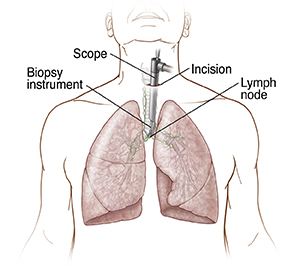Surgical Diagnosis of Chest, Lung Problems
You’ve been told you need a surgical procedure to diagnose a problem in your chest or lung. These procedures are used to get samples of tissue or lymph nodes from the chest or lung. These samples allow for complete testing and an accurate diagnosis. Surgical procedures often require cuts (incisions). It may take some time to recover from them.
Mediastinoscopy
Mediastinoscopy lets the healthcare provider see inside the area between your lungs (the mediastinum) and remove large lymph node samples (biopsy). First, an incision is made at the base of the neck. A thin tube (scope) is passed through the incision into the mediastinum. Then, a biopsy tool is passed through the scope. Once the lymph node sample is taken, the tool is pulled up through the scope. The sample is then tested for cancer or other problems.

Video-assisted thoracic surgery
Video-assisted thoracic surgery (VATS) is a minimally invasive surgery. It lets the healthcare provider see inside the chest and take tissue samples without using a large incision to open the chest. VATS uses a thin tube with a light, lens, and camera (thoracoscope). First, a small incision is made on the side of the chest. The scope is passed through the incision into the space between the lungs and chest wall (pleural space). Images of inside the chest are sent to a screen. They are viewed by the provider. Other small incisions are made for tiny tools to pass through and remove tissue. VATS can also help diagnose and stage cancer.

Thoracotomy
In some cases, open surgery is needed to diagnose and treat a lung or chest problem. If so, incisions are made, and the chest is opened. This lets the healthcare provider see inside the chest. They can also take a sample of lung tissue or a mass.
Getting ready for the procedure
Before your procedure, do the following:
-
Talk to your healthcare provider about any questions and concerns you have.
-
Follow any directions for not eating or drinking before the surgery.
-
Tell your provider about all the medicines you take. This includes over-the-counter and prescription medicines, vitamins, herbs, and other supplements. You may need to stop taking some medicines before the procedure. This may include aspirin, warfarin, or other blood thinners.
-
Discuss any allergies and health problems with your provider.
-
Tell your provider if you are pregnant or think you might be pregnant.
During the procedure
You will be given medicine to make you sleep (general anesthesia) during the procedure. Once you're asleep, incisions are made in the neck, chest, side, or back. This allows the healthcare provider to examine the area and take a biopsy if needed. A tube placed in the chest during surgery drains fluid.
Risks and possible complications
Online Medical Reviewer:
Chris Southard RN
Online Medical Reviewer:
Marianne Fraser MSN RN
Online Medical Reviewer:
Sravani Chintapalli
Date Last Reviewed:
3/1/2024
© 2000-2025 The StayWell Company, LLC. All rights reserved. This information is not intended as a substitute for professional medical care. Always follow your healthcare professional's instructions.